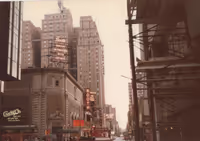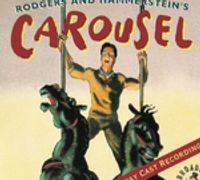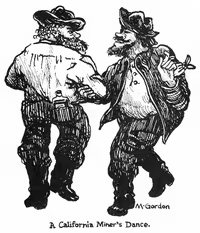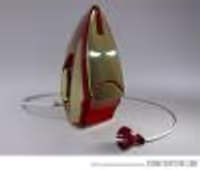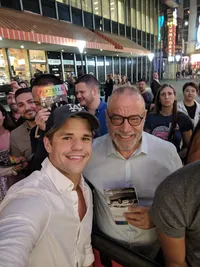Best Scene Changes
#50Best Scene Changes
Posted: 8/29/19 at 12:02pm
The original Carrie’s transition to Don’t Waste The Moon was also pretty spectacular, with all those headlights coming out of the darkness.
Yerma definitely deserves mention here, mostly for the fact that the transitions were so quick in the darkness. I remember reading about how they did it, but I’ve forgotten - does anyone remember?
SueBee06
Stand-by Joined: 1/12/16
#51Best Scene Changes
Posted: 8/29/19 at 12:08pm
SouthernCakes said: Also at the National: at the end of Angels Part 1 when the entire stage floor moves back and an entirely new stage floor is brought into place is just a technical marvel that had me gasping!"
It really was extraordinary and is only possible in a rep space set up like theirs. As a side note, I highly recommend the backstage tour they offer. It was a really fantastic peek into how the complex is laid out and how they're able to do things like this.
SueBee06
Stand-by Joined: 1/12/16
#52Best Scene Changes
Posted: 8/29/19 at 12:16pm
The entire sequence starting from the beginning of The Angry Dance in Billy Elliott through to the end is one that stands out in my memory. That was one of the most effective uses of props, projections, lighting, and scenery with staging and choreography that I've seen.
Updated On: 8/29/19 at 12:16 PM#53Best Scene Changes
Posted: 8/29/19 at 12:32pm
I remember watching a YouTube video on this. Basically on either end of the stage they had 2 stage decks that could slide on. So while one scene was happening another was being set up, etc.
#54Best Scene Changes
Posted: 8/29/19 at 1:18pm
I don't know how it looked, but I music directed "High School Musical 2" during its soft launch in 2009, and there's some extremely "dramatic" music for the scene change from the high school to the country club. It must have been designed to play up a grandiose transition, but nothing is noted in the script and it was just a blackout in this production.
That could almost be another thread: "things the music tells you that the licensed script does not even imply."
brian1973
Leading Actor Joined: 2/1/14
#55Best Scene Changes
Posted: 8/29/19 at 6:01pm
MollyJeanneMusic said: "How could I forget Higgins's house in the new My Fair Lady revival?"
What , a big lump of set lumbering downstage? No thanks.
#56Best Scene Changes
Posted: 8/29/19 at 6:31pm
brian1973 said: "MollyJeanneMusic said: "How could I forget Higgins's house in the new My Fair Lady revival?"
What , a big lump of set lumbering downstage? No thanks."
I can't speak for MollyJeanneMusic, but I thought they might have meant the part where we see Eliza moving through the house, and the revolve is used to allow us to follow her through the rooms. I thought that was a really brilliant use of the set, not just as a staging tool, but also as a means of emphasizing that the production was meant to be very focused on Eliza's journey.
#57Best Scene Changes
Posted: 8/30/19 at 7:57pm
YERMA! the <10 second scene changes in Yerma were...."wait what....how'd they do that".
#58Best Scene Changes
Posted: 8/30/19 at 8:21pm
Broadway Bob* said: "It might seem cliché', but the first time the mansion silently floated from the rafters onto the Minskoff stage in SUNSET BLVD. was breathtaking and awe inspiring. That anything that huge could move so swiftly and quietly left me speechless."
Yeah? And the fact that "heavy" marble and terrazzo floated silently made you think/feel what, exactly?
That and the scene change where the Phantom and Christine exit into the floor and instantly appear on the highest catwalk are two of the worst scene changes in my life.
Destroying all theatrical illusion just to be "cinematic" is pretentious and self-defeating on stage.
SouthernCakes
Broadway Legend Joined: 7/29/19
#59Best Scene Changes
Posted: 8/30/19 at 8:37pmThose are 2 great examples of theatrical illusions...
#60Best Scene Changes
Posted: 8/31/19 at 3:00am
I'm shocked that no one has mentioned CITY OF ANGELS, and the 'walk into the mansion.' I think that was the first time I'd seen such a blend of projections and physical set pieces that worked so seamlessly that it seemed like a film. It's still one of my favorite theatrical memories.
MollyJeanneMusic
Broadway Star Joined: 3/10/19
#61Best Scene Changes
Posted: 8/31/19 at 8:35am
JBroadway said: "brian1973 said: "MollyJeanneMusic said: "How could I forget Higgins's house in the new My Fair Lady revival?"
What , a big lump of set lumbering downstage? No thanks."
I can't speak for MollyJeanneMusic, but I thought theymight have meant the part where we see Eliza moving through the house, and the revolve is used to allow us to follow her through the rooms. I thought that was a really brilliant use of the set, not just as a staging tool, but also as a means of emphasizing that the production was meant to be very focused on Eliza's journey."
Exactly! I also really loved the staging of "Just You Wait," where Eliza walked through all different parts of the house as though she ruled it, then triumphantly walked back into Higgins's study on "And they'll march Henry Higgins through the wall..." It was such a cool way to show how strong Eliza was, and how much she truly wanted this advancement in her language.
#62Best Scene Changes
Posted: 8/31/19 at 2:02pm
The opening set piece for the recent revival at Lincoln center of The King & I with the ship coming into harbor...breathtaking...and the opening transition in An American In Paris, which went from one of the leading male performers along on stage to transitoning into post war Paris with huge backdrops of the French flag and the city...also breathtaking and it won a Tony for sets as well that year!
evic
Broadway Star Joined: 3/5/04
#63Best Scene Changes
Posted: 9/2/19 at 12:22am
A similar scene change to Carrie occurred during the final scene change in another flop-Nefertiti. The giant staircase unfolded from the rafters just as the one in Carrie did. Very spectacular. And like Carrie, it had some beautiful music.
#64Best Scene Changes
Posted: 9/2/19 at 12:38amI can’t imagine anything topping Yerma. It was both breathtakingly cinematic and absolutely perplexing.
#65Best Scene Changes
Posted: 9/13/19 at 11:21am
One that I just remembered, although it's the music that does the heavy lifting and not the scenery: the transition from Vegas back to New Jersey in the finale of "The Wedding Singer."
We get a quick blast of the show's main theme from "It's Your Wedding Day," and then the band transitions (for the only time in the show) to playing New Jersey-style rock and roll, glockenspiel and accordion and all, to signify we've made it back to Jersey. It's a subtle thing, you kind of have to know Jersey rock in the eighties to get it, but it's such a clever use of musical signifiers.
Pashacar
Broadway Star Joined: 11/2/18
#66Best Scene Changes
Posted: 9/13/19 at 3:28pm
1984 stunned me scenically. An hour in, sirens came on and government agents in something like gas masks appeared to dismantle the set we'd been living in for "months," piece by piece. What remained was a plain white box lit by fluorescents. It was harrowing and impressive.
ArtfulAmy17
Swing Joined: 3/22/15
#67Best Scene Changes
Posted: 9/13/19 at 3:34pm
SueBee06 said: "The entire sequence starting from the beginning of The Angry Dance in Billy Elliott through to the end is one that stands out in my memory. That was one of the most effective uses of props, projections, lighting, and scenery with staging and choreography that I've seen."
YES! Especially that moment when the police shields slam down in unison to form a wall behind Billy, on cue with a bold blue lighting change, as Billy launches into pirouettes. I'm curious how the Goodspeed production is handling the staging (I'll find out next month!).
SouthernCakes
Broadway Legend Joined: 7/29/19
#68Best Scene Changes
Posted: 9/13/19 at 5:46pmArtfulAmy love to hear your review! Have friends in the cast!
#69Best Scene Changes
Posted: 9/13/19 at 6:04pm
I don't know if this has anything to do with "Best Scene Changes", but I remember when I saw the original tour of "La Cage Aux Folles" in Cincinnati, there was tremendous applause for almost all of the scene changes, especially the one toward the end for the "Chez Jacqueline" scene where "The Best of Times" is sung...the only other time was when the late Keene Curtis sang, "I Am What I Am"...
ArtfulAmy17
Swing Joined: 3/22/15
#70Best Scene Changes
Posted: 9/13/19 at 6:33pm
SouthernCakes said: "ArtfulAmy love to hear your review! Have friends in the cast!"
SouthernCakes, that is so awesome for your friends to be part of "Billy Elliot" at Goodspeed! I'm really looking forward to seeing it and I'll be sure to share my thoughts :)
I'll also add to others' comments about the original staging of "Les Mis" and the indelible imagery of the hulking barricade halves tilting 90 degrees as they coming together then split apart, and the 360 degree revolving that occurs in between during and after the battles. It's a true shame that staging is now gone...
dadaguza
Stand-by Joined: 7/16/19
#71Best Scene Changes
Posted: 9/13/19 at 8:02pm
In Beautiful, I love how they transition from the scenes that show Carole/Gerry and Cynthia/Barry writing the songs, into the scenes of the singers they wrote the songs for performing them.
(Examples: You've Lost That Lovin' Feeling and Will You Still Love Me Tomorrow)
#72Best Scene Changes
Posted: 6/3/20 at 5:55pm
When the hotel set breaks apart in "The Mountaintop" near the end and she stood there and delivered that killer speech. My jaw kinda dropped. It was just visually stunning.
Jarethan
Broadway Legend Joined: 2/10/11
#73Best Scene Changes
Posted: 6/3/20 at 7:44pm
-- Effie's ending 'And I am Telling You' segueing to the new Dreamgirls appearing on stage has got to be on the top of any list. The audience was deprived from raining the roof and that made it more exciting.
-- Agree re the original production of Follies transitioning to Dreamland. Incredible, theatrically historical moment.
-- Agree re the citing of the mansion in A Weekend in the Country, for my money one of the greatest numbers Sondheim ever wrote and Prince ever staged. An entire story in a single number, staring in multiple homeland ending in the country.
-- I don't know if this is the qualifies as a scene change but, for my money, one of the most exciting moments in musical theatre is when the train pulls into and out of the station during Put on Your Sunday Clothes.
-- There was an incredibly magical moment in Nicholas Nickleby, when Nicholas takes a ride on a coach. The construction of the coach was one of the most magical moments I have experiences on the stage.
-- The end of Nine. Suddenly the white of the stage is emphasized, but is also complemented with an aquamarine glow across the stage. As the music is crescendoing, doves are released into the auditorium. As beautiful a stage image as I ever expect to see.
-- One of the most boring evenings I ever spent in the theatre. The show was Agamemnon at the Vivian Beaumont, directed by Andrte Serban. The entire audience is on multiple moving seating areas (think stadium sections, but movable. Several scene changes were made not by moving scenery, but by moving the audience. A moment of incredible creativity in an other wise miserable evening. Perhaps it would have been better if the dialogue was in English OR there were supertitles somewhere. As it is, I seem to think that it was not even in Greek, but rather some made up language. I could be wrong there.
-- The first time you see the mansion in Sunset Blvd. Naysayers say the set was too overwhelming and probably contributing to the show's financial failure; however, that was a very exciting moment.
-- The house comes tumbling down in An Inspector Calls. A very impressive design feat and perfect in the context of the show. There was a similar scene transition in Indiscretions, a decade or so later I imagine, but it would have been more effective if one did not have the memory of An Inspector Calls.
Lots of others, but I just can't think of any that are as impactful as the ones above.
#74Best Scene Changes
Posted: 6/3/20 at 9:07pm
Deleted. I didn't realize this was an old thread and I had posted my complaint about the SUNSET BOULEVARD set before.
Updated On: 6/3/20 at 09:07 PMVideos


